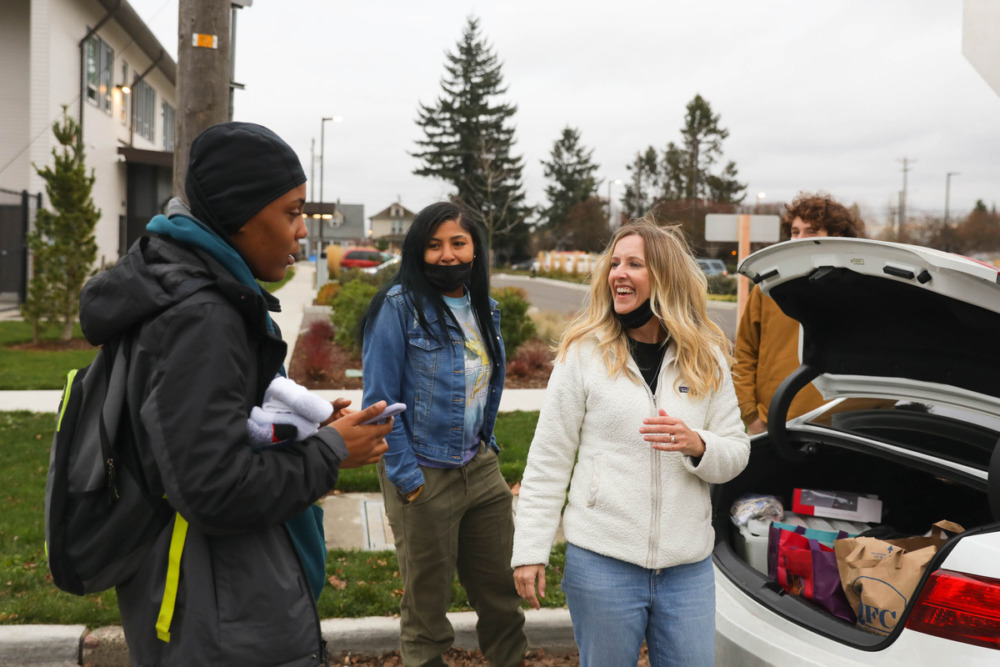Before the pandemic, Jordan Gilbert would meet the homeless young people she’s charged with helping in schools, parks, libraries and drop-in centers where they can get a shower and a hot meal.
After making those connections, Gilbert, the interim manager for the REACH Center’s housing assistance program, called ACT, would encourage her 12- to 24-year-old clients to show up and apply for aid at the Tacoma, Wash., agency, whose name is shorthand for Resources for Educational Advancement, Careers, and Housing. If those clients needed gas or groceries, Gilbert would meet them at the point of purchase to pay for it.
Listen and follow: Spotify | Apple Podcasts | Google Podcasts | Pocket Casts | RadioPublic
But when schools closed and the state locked down against COVID-19 in March 2020, Gilbert and many employees at organizations serving homeless youth felt a wave of panic. How would they aid students trying to attend school remotely from inside a car? Or reach kids quarantining in crowded homes where money for food and rent already was stretched thin?
“My biggest concern was, how are we going to serve these youth and young adults, and how are we going to help them stay safe?” Gilbert said of those first days. “And then my other thought was, ‘Oh, my gosh, my team? How are we going to keep them healthy and still do our jobs? We can’t shut down.’”
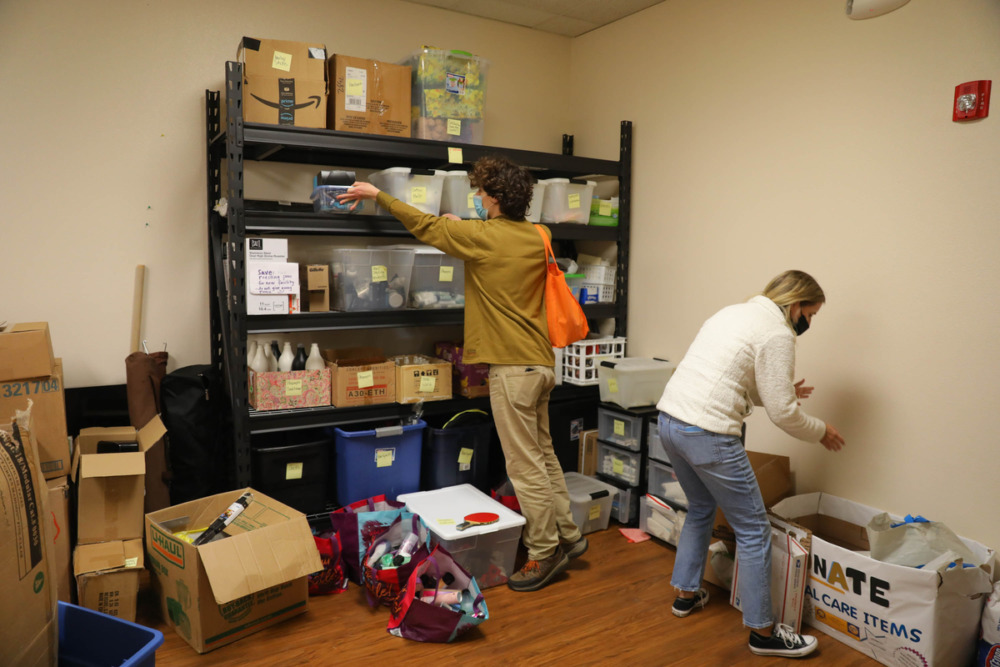
Genna Martin/Crosscut
Julie Easley (right), a director at The Coffee Oasis in Tacoma, Wash., and Americorps volunteer Nolan Hibbard-Pelly gather toiletries, warm clothing and other items ahead of their street outreach to homeless clients in Tacoma, Dec. 3, 2021.
But Gilbert also was “a little excited.” She saw an opportunity to make the ACT program more accessible and appealing to young people by moving more of its services online.
Within two days of the state’s COVID-19 shutdown, Gilbert, 30, set up a Facebook page and an online form, in English and Spanish, where youth could request assistance at their convenience. The REACH Center, which also connects youth with education, employment and health care, created a live web chat and began sending youth money for food or other modest needs via PayPal.
“We were very nervous that we would have zero clients because we couldn’t be out in the community reaching out to them and connecting with them,” said Devon Isakson, REACH interim director.
Instead, the number of young people reaching out to the organization exploded. REACH worked with more than 800 youth in 2021, up from 300 in the 12 months prior to March 2020. Isakson attributes the increase to both greater accessibility and increased needs.
![]()
When schools closed and the states locked down against COVID-19 in March 2020, employees at organizations serving homeless youth felt a wave of panic.
This story and podcast are part of an ongoing series on homelessness in Washington state, done in collaboration with Crosscut. It is made possible, in part, by support from the Raikes Foundation. Youth Today and Crosscut maintain editorial control. Find links to more stories, podcasts and videos in the series at the end of this story.
![]()
The shift to virtual outreach “has completely changed the dynamic of how we communicate with youth and young adults because we are meeting them where they are,” said Gilbert, who briefly was homeless when she was starting as an ACT program intern in 2019.
As COVID-19 upended their usual protocols, some nonprofits that didn’t manage to alter their outreach strategies saw the tally of homeless youth they served plummet. But for other organizations, in Washington and nationwide, the pandemic spurred innovations in how they find and serve a population whose needs were amplified and, in some ways, made more acute because of COVID-19.
Like REACH, a number of service providers adopted online and telephone-based options for young people to apply for housing, attend support groups and connect with case managers, mental health counselors and doctors. Other groups went in the opposite direction, delivering food and other supplies directly to youth and their families wherever they were sheltered, including in cars and motel rooms.
Several organizations across the country also began experimenting with giving cash directly to young people, allowing them to determine how best to meet their own needs. One of those is Point Source Youth, which, in partnership with Chapin Hall at the University of Chicago, is piloting monthly $1,250 cash transfers to young adults in New York and California.
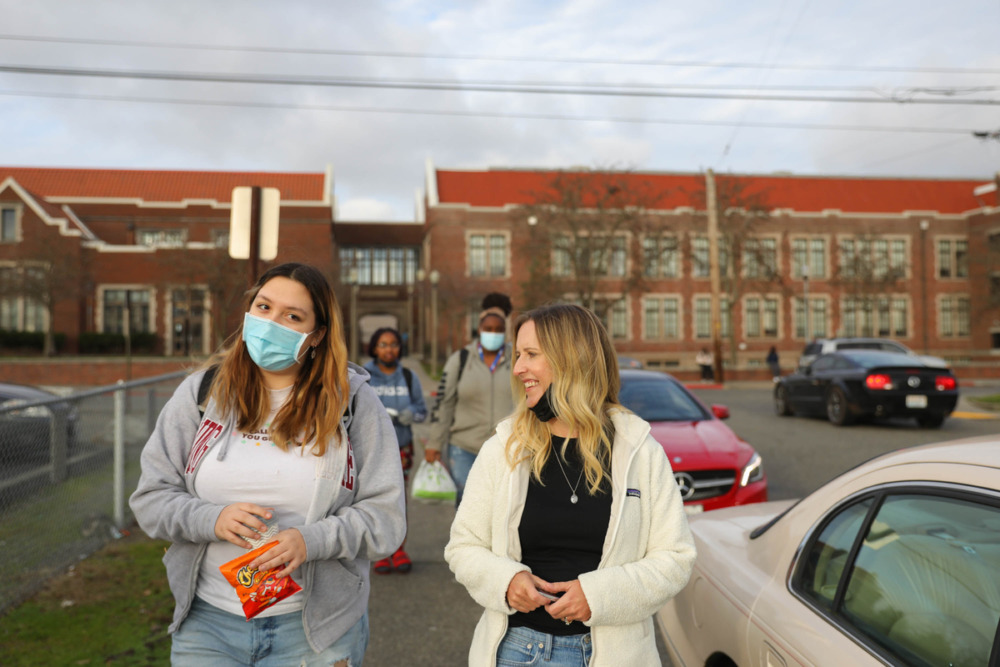
Genna Martin/Crosscut
The Coffee Oasis Director of Youth Programming Julie Easley, right, talks with Sofia Bonds, 16, outside Tacoma’s Lincoln High School, during an afternoon of doing street outreach to homeless youths in Tacoma, Dec. 3, 2021. Easley provides information about her agency’s homelessness services.
“The pandemic exploded a lot of preconceived notions that young people experiencing homelessness have to go through certain hoops, have to show up in certain places, have to take certain assessments,” said Larry Cohen, co-founder and executive director of Point Source Youth, which supports service providers across the country with training, evaluation and advocacy. Instead, Cohen said, more organizations are reimagining their services to reflect what young people who have experienced homelessness say they need.
In another example of service providers trying something new, staffers at The Night Ministry in Chicago helped connect homeless young people with telehealth appointments when they couldn’t get a face-to-face with their physicians; and handed them boxes of donated food while they waited, sometimes for months, to re-qualify for food stamps.
Service providers, and funders too, “are much more open to new ways of doing things,” Cohen said, “because it’s been clear in really painful ways that the old way hasn’t worked.”
That’s clear from the numbers: Nationwide, at least 4.2 million young people aged 13 to 25 experience homelessness each year, according to a 2017 national survey by Chapin Hall. A majority reported having lived in a car, tent or other place “not meant for human habitation,” or in temporary housing such as a homeless shelter. And in Washington, more than 40,000 students, including 5,736 in Pierce County, where Tacoma is located, were homeless during all or part of the 2018-2019 school year, according to Building Changes. Students of color were disproportionately numbered among them, according to the latest data available, making up 46% of the state’s under-18 population but 61% of homeless students.
“The bottom line is, a lack of housing and a lack of services for young people who are experiencing homelessness means we are going to see prostitution, prison and death,” said Shawna Kemppainen, executive director of The Place, which provides emergency shelter and street outreach in Colorado Springs, Colo. The pandemic spurred the nonprofit to open a new drop-in center and begin building 50 units of permanent supportive housing for young adults. “So we have to step up and do more of this across the country.”
Post-pandemic, some intake and outreach will remain online
As a second year of the pandemic nears an end, REACH and some other similar organizations have returned to meeting young people in schools and other reopened spaces. But the new online offerings, at least at REACH, are here to stay, Gilbert said.
Virtual outreach has several advantages, she noted. Back when she was doing client intake in person, getting honest answers could be difficult. “A lot of the times I was getting hesitant answers,” Gilbert said. “Or I would get no response, or I would get a lie.”
Online, she said, applicants often are more forthcoming about their circumstances.
Sometimes youth are nervous or embarrassed to go into an agency to ask for help, REACH manager Isakson said. The online form “totally took away that kind of power imbalance.”
Plus, Isakson added, youth can fill it out at night or on weekends, instead of having to show up for a two-hour meeting during business hours. And they don’t have to figure out transportation, which poses another barrier for many people who are homeless.
Despite these advantages, a lack of steady or reliable internet access can be a barrier for those seeking help remotely, Gilbert acknowledged. But youth are skilled at finding ways to get online, she said. “They will sit at Starbucks, and they will do whatever they need to do to get the support that they need because they’re so resilient.”
When needed, the seven outreach specialists in REACH’s ACT program still meet young people face-to-face. This hybrid approach is critical because not all youth prefer virtual communication
Vy Vu, the ACT program’s first youth “lived-expert” peer outreach specialist, who recently was homeless, is one of them.
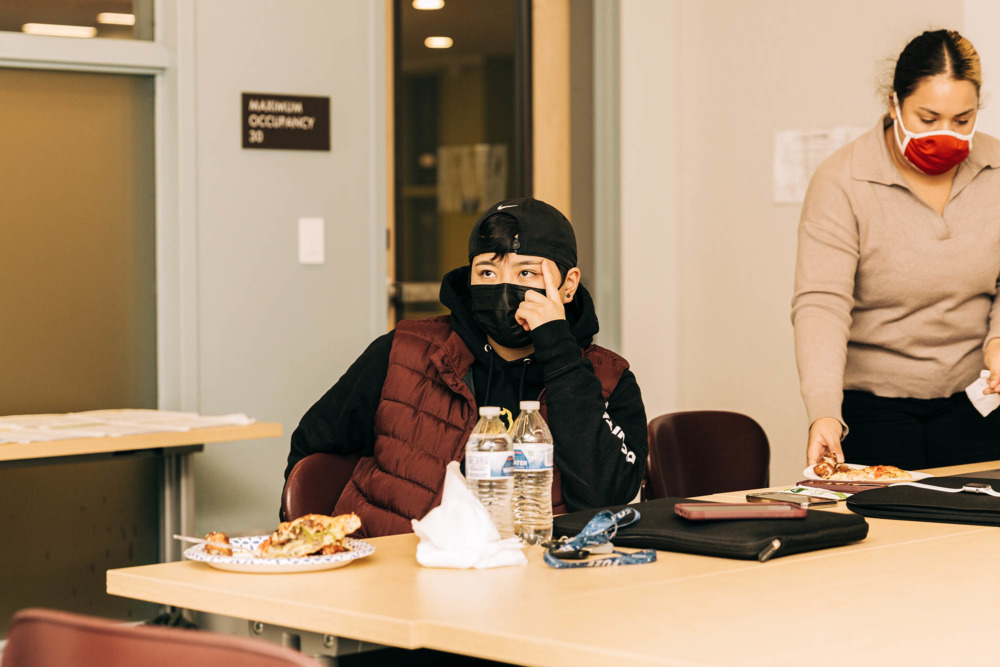
David Jaewon Oh/Crosscut
Vy Vu, a peer outreach specialist, during a Youth Action Board meeting at Tacoma Community House on Dec. 22, 2021. Vu is the ACT program’s first youth “lived-expert” peer outreach specialist. Vu, who identifies as nonbinary, recently experienced homelessness themself after leaving an abusive home environment at 17, and uses that experience to do outreach to currently homeless youths.
Vu, 22, who identifies as non-binary and left an abusive home shortly before turning 18, said they never felt accepted by their family. Queer and trans young adults experience homelessness at twice the rate of their non-LBGTQ peers, according to research by Chapin Hall. A 2020 national survey by the Trevor Project found that 29% of homeless LGBTQ youth and young adults had been kicked out of the house or run away.
Vu had been living in their 2006 Toyota Camry on and off for about three years and were anxious to get into housing when they reached out to the ACT program last summer. Yet, Vu found trying to collaborate with an ACT outreach specialist via phone and text frustratingly slow. “Talking,” face to face, Vu said, “you can get things done a lot faster.”
Last August, Vu signed a lease on the first place they could find, a one-bedroom apartment for $1,450 a month. REACH, using state and private grants, cut the landlord a check for about $1,800 to cover the security deposit and first month’s rent. Around the same time, Vu started their job with ACT, which allows them to pay the full rent themselves.
Despite their own preference for in-person help, Vu said a lot of their peers prefer texting because they feel anxious speaking with strangers and uncomfortable asking for help. For others, Vu added, work and child-care obligations, transportation challenges, and the daily uncertainties and stresses of living without stable housing also make it hard to show up for an appointment. “You adapt to your participant, and that’s how it should be,” Vu said.
In Colorado, The Place also found that face-to-face interactions can play an important role in getting kids off the street.
During the first year of the pandemic, The Place served 20% fewer youth and young adults in its street outreach and in its 20-bed emergency shelter, according to Kemppainen. With libraries, youth-friendly coffee shops and other safe indoor spaces closed, she said, the need for a drop-in center where youth could come inside, get a meal, charge their phone and connect with a case manager became more urgent.
So The Place repurposed a nearby LGBTQ center that had ceased in-person activities to pilot a homeless youth drop-in center from December 2020 through March 2021.
Having that point of contact with young people proved critical in getting them housed, Kemppainen said. Compared to the previous year, the nonprofit saw six times the number of youth exit the street to housing because they were able to get to know drop-in center staff who could sign them up for one of several housing programs.
That success helped accelerate the creation of a permanent drop-in center last December, something The Place had been wanting to do for several years. “The pandemic lit a fire under the need for opening a drop-in center,” Kemppainnen said.
The Place also is building a larger emergency shelter and 50 units of permanent supportive housing for young adults. “The pandemic really brought the need for housing even more into focus,” Kemppainen said. Nationwide, 35% of youth and young adults who applied for housing were offered a place, according to a November 2018 Chapin Hall study; those who were selected waited an average of four months or more for the offer.
Caseloads soar; workers head outdoors to find youth
When Gov. Jay Inslee ordered all Washington schools to close in an effort to slow COVID-19’s spread, Julie Easley was alarmed. “I was, like, ‘No! I need to get to my kids,’ ” said Easley, referring to those she’d been serving as the sole outreach specialist for The Coffee Oasis in Tacoma. The nonprofit conducts homeless youth outreach and has drop-in centers and 18 emergency shelter beds for youth and young adults in Kitsap and Pierce Counties.
“I have youth that were already having so many obstacles,” she continued, “so much instability.” Then they were being told to quarantine, Easley said, but often they didn’t have a safe place to stay. Some, for example, were living in cars, while others found themselves no longer welcome in homes where they had been couch surfing.
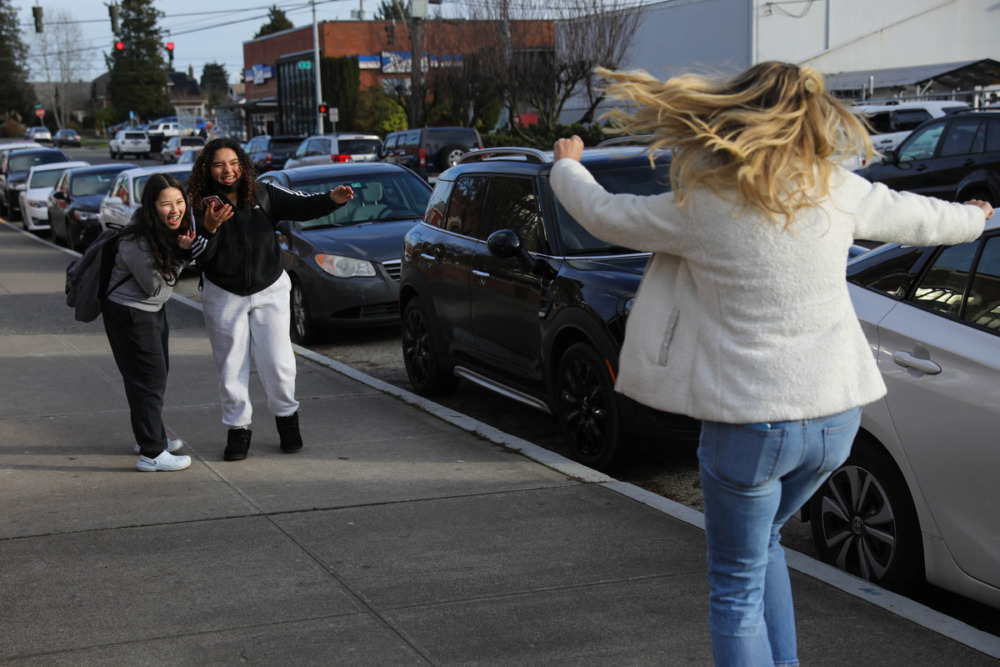
Genna Martin/Crosscut
Breaking from delivering essentials to homeless youth, The Coffee Oasis’ Julie Easley dances — from a distance — in front of two Lincoln High School students during an afternoon doing street outreach to homeless youths in Tacoma, Dec. 3, 2021. Easley often spends time getting to know local high schoolers, making connections that can pay off down the road if they or their friends need help.
Like Gilbert at REACH, Easley was abruptly unable to connect with her clients at libraries, drop-in centers, basketball courts and other regular haunts. And Easley knew that school is where many youth get meals and counseling and make important connections with friends, teachers and other stable adults.
When it became clear that life would not return to normal after the initial, two-week lockdown, Easley knew she’d have to figure out alternative means of contacting her clients.
Instead of a computer, Easley turned to her car. Starting with the youth she already knew, she began providing food, clothing, personal protective equipment and other essentials.
“‘I’m still here, and I can still drive, and we still have supplies, and, so, let’s figure this out,’” she told herself. “I’ll admit,” she added, “I didn’t really have, like, some master plan.”
Word quickly spread. When Easley would meet a kid in her compact car to shuttle them to the food bank, they often would have three friends in tow.
“I have times where we had so much food in the trunk, and the kids would have boxes on their laps, and we would bring them to grandmas that were taking care of them … and to families that were letting them couch surf,” Easley said. Those visits also let her get to know and support relatives of youth.
Easley said she worried more about the youth than about COVID. “Not because I didn’t want to be safe and protect others,” she said, “but I really needed to engage the youth with where they were at.”
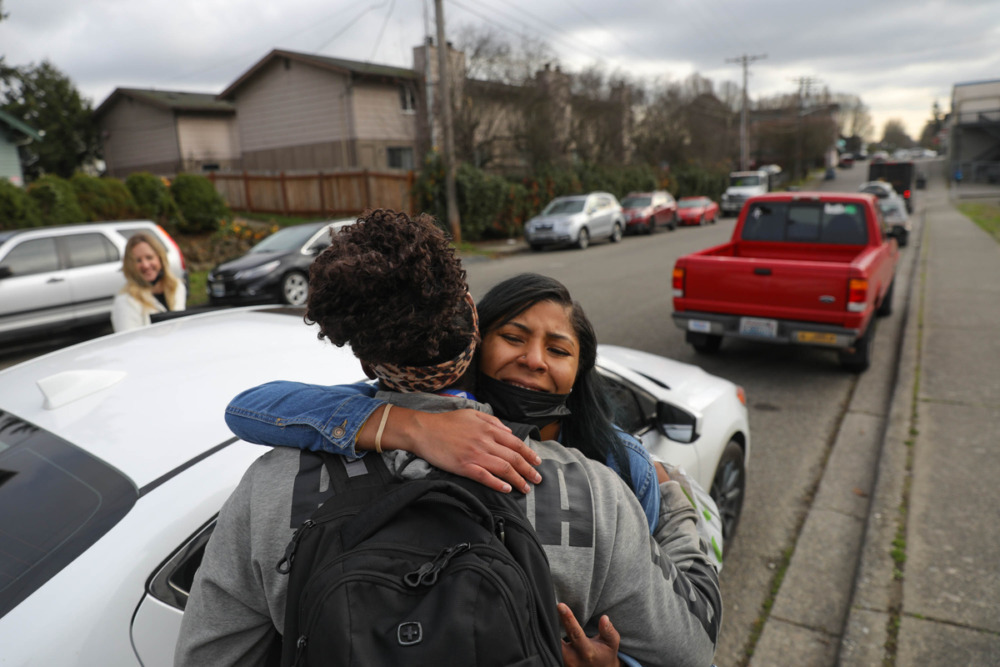
Genna Martin/Crosscut
The Coffee Oasis’ RoNae Marshall, a youth outreach engagement specialist for homeless youth, hugs high school student high school student Portarette, 17, during an afternoon of outreach in Tacoma, Dec. 3, 2021.
For those living with a vulnerable grandparent, she would drop food off at the doorstep and chat outdoors from a distance. As masks became more available, she carried and offered them to her clients, but she didn’t force the issue.
“Overall, my love for the youth won over my concern for COVID,” she said.
Easley’s caseload ballooned to 80 teens, up from 55 pre-pandemic. She drove them to court hearings and doctor’s appointments and helped them register for school. She has been by the sides of two 17-year-old clients through their pregnancies, attending medical appointments and ultrasounds, but she wasn’t able to be at their babies’ births due to COVID.
Such “mobile case management,” as Easley calls it, has allowed her to build trust with youth, and with their families, by supporting them through important life events. They have continued to reach out when challenges have arisen, including when they have had a car accident or received an eviction notice.
In March, Easley became Pierce County youth programs director for The Coffee Oasis, which operates statewide. A recent grant will let her hire three new outreach workers who will continue the in-person service model she pioneered.
Youth are entrusted to utilize cash stipends
Another change accelerated by the pandemic involves giving cash to young people and trusting them to spend it on whatever they need.
During the pandemic, REACH began giving out one-time amounts of up to $250 for necessities such as food, transportation and personal hygiene. Youth tell REACH what they want the money for, but they don’t have to provide a receipt or otherwise prove how they spent it. Most requests are for about $50.
“It changed the game for us,” Isakson said. It allows staff to serve more youth because they’re not spending two hours meeting one person to buy them groceries.
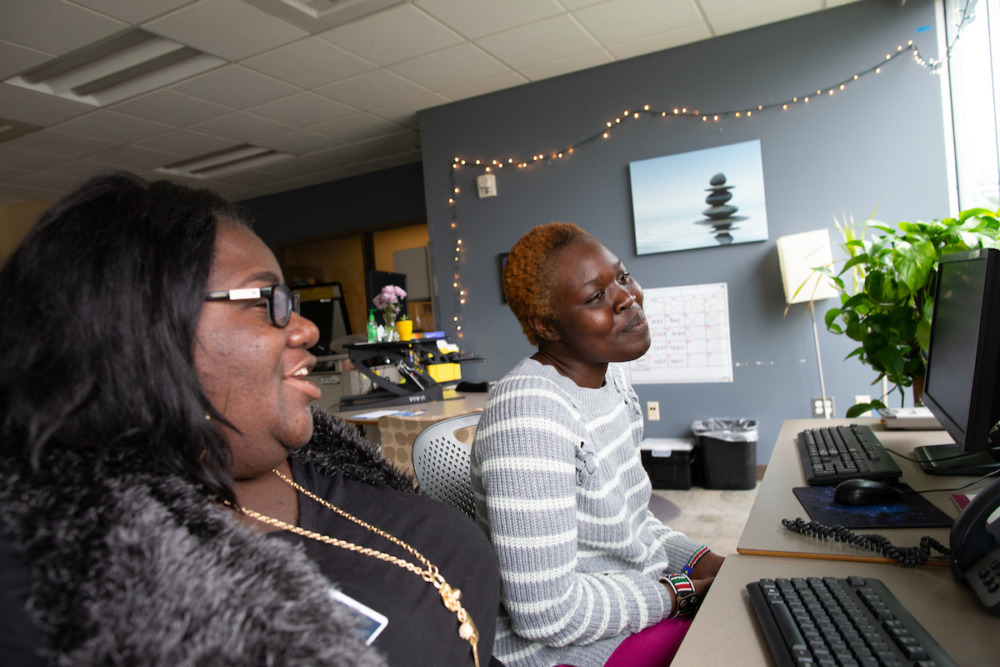
Karen Ducey/Crosscut
(Left to right) Jordan Gilbert, a staffer at Tacoma’s REACH Center, helps aspiring student Ayom “Mimi” Arop, 21, fill out credit card applications in a computer room utilized by the center’s homeless clients on Aug. 22, 2019. Arop wants to go to school to become a nurse. She came to REACH for help getting on her feet. “I want a life of my own,” she said.
It also empowers young people, she and Gilbert added. Young adults “still have the right to make their own decisions,” Gilbert said. “And we trust that the youth, the young adults, are going to do what they need to do.”
A young person might be afraid to say they need $50 for HIV prevention medication and, instead, say it’s for gas, Gilbert said. “That’s not my place to judge,” she said. “I just want to make sure your needs are met.”
In New York City, San Francisco, Oakland and Los Angeles, another new cash transfer program is testing whether giving young adults $1,250 per month — an amount that reflects the cost of housing, usually with a roommate, in those cities — will result in long-term housing stability for 30 to 100 participants in each city. Called the Trust Youth Initiative, the program will provide the cash, along with optional support services, for up to two years. Point Source Youth is overseeing implementation and Chapin Hall will evaluate the results.
The effort, Point Source Youth’s Cohen pointed out, costs considerably less than housing young adults in congregate shelters. New York City spent more than $50,000 per shelter bed in fiscal year 2021.
“We have to trust young people as experts in their own lives,” Cohen said. And given that youth of color and LGBTQ+ youth are so overrepresented among the homeless population, “it quickly becomes, trust Black youth, trust trans youth, trust BIPOC youth,” he said. “That is what’s morally required.”
Such cash transfers have been rare in the United States, although research has shown them to be successful at alleviating poverty in other countries. That’s partly because government and private grants to nonprofits typically limit how funds can be used and require careful tracking of how they are spent.
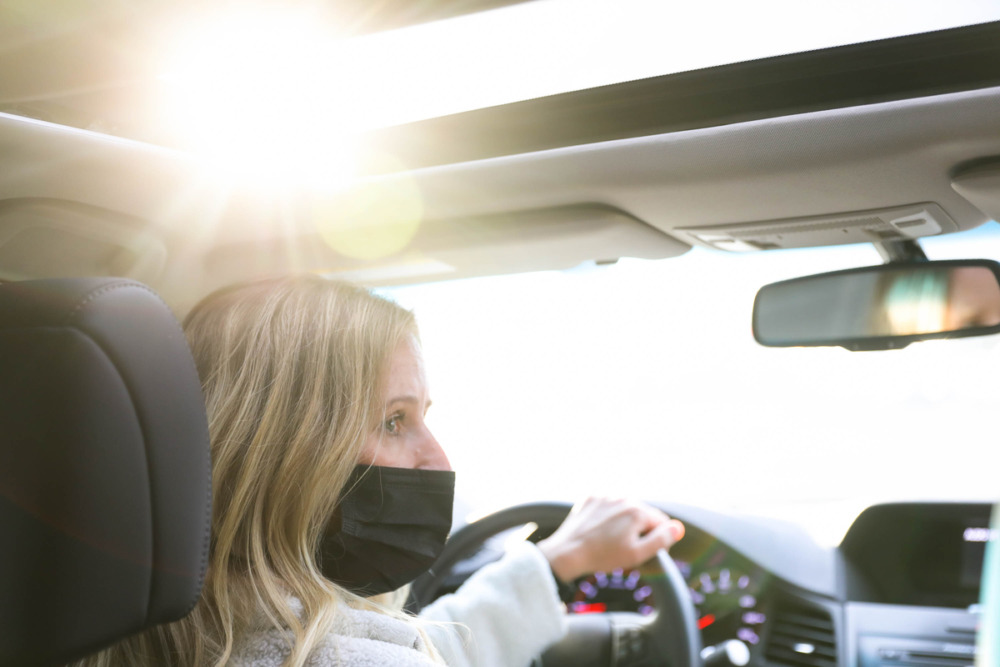
Genna Martin/Crosscut
Meeting her clients during drives around her region, instead of at her office, is one of the changes that COVID-19 forced on The Coffee Oasis’ Julie Easley and on some of her counterparts at organizations for homeless youth across the nation.
The stimulus money that all Americans received during the pandemic helped shift the conversation among funders, Cohen said. No one, he pointed out, asked people, “Did you buy Chardonnay with your stimulus payment?” And those payments worked to improve people’s ability to afford food, rent and other necessities, while reducing depression and anxiety.
The Trust Youth Initiative is funded by a combination of state, local and foundation dollars. In Washington, one of REACH’s private funders gave it permission to use an existing grant for the cash transfers; the group hopes to continue them as long as funding is available.
REACH and other groups say philanthropies not only boosted their giving during the pandemic but also trusted service providers to spend it in ways that best help young people, often with young people’s input. REACH, for example, was able to use some emergency funds to hire Vu, one of its own program graduates, to guide other struggling young people.
Even when the emergency funding dries up, said Isakson, REACH is determined to stay relevant and accessible to the young people it serves. “We really just don’t want to be that antiquated model of a social service agency,” she said.
Related videos, stories and podcasts
- Video and story: Washington state young adults often end up homeless after leaving treatment
- Video and story: Education for young people in shelters was already a challenge — then coronavirus hit
- Podcast and story: Youth leaving foster care, juvenile and other systems are aim of Washington housing effort
- Podcast and story: Washington’s new youth homelessness ‘Lifeline’ service lags
***
Allegra Abramo is a freelance writer whose stories and photos have appeared in ProPublica, NBCNews.com, InvestigateWest, and other local and national outlets. She grew up on the East Coast but loves the mountains and trees of the Pacific Northwest too much to ever go back.
Sam Leeds is an independent producer and sound artist living in Seattle. They are passionate about reporting that examines systems of power and approaches the people who agree to share their voices with deep care. You can hear their work on NPR Music’s Louder Than A Riot, Life Kit, KNKX’s Sound Effect, and more.
This story is part of an ongoing series on homelessness in Washington state, done in collaboration with Crosscut. It is made possible in part by support from the Raikes Foundation. Youth Today and Crosscut maintain editorial control.


